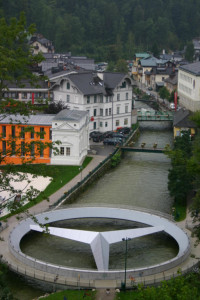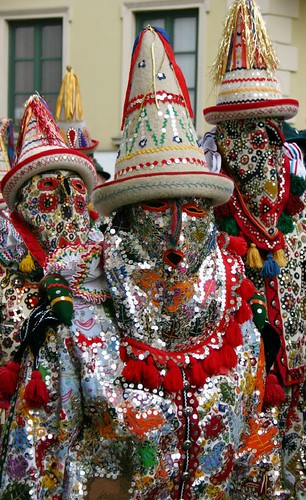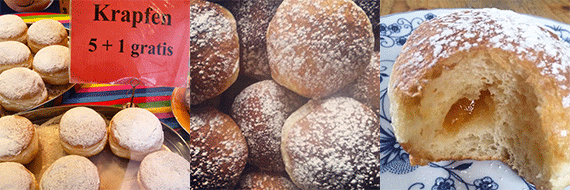
The first time I visited the town of Bad Aussee, my brain fritzed out a little; irony wired city hipsters like me have a hard time processing a place where lederhosen and dirndls are common attire, even amongst the young. Bad Aussee is very pretty; it’s a spa town but it came to regional prominence as a center for the salt trade. It’s held on to tradition, though you have to over look the eyesore of a pedestrian bridge that’s in the shape of a Mercedes hood ornament. Bad Aussee has a very good bakery, the Temmel/Lewanadowsky, in a grand salon on the main square and they have a remarkable parade for Fasching, or Austrian Carnival.

There are a lot of traditions specific to Carnival in Bad Aussee. There’s a whole range of characters that march in the parade but the my favorite are the “flinserl” — they wear elaborately embroidered costumes that are covered in tiny mirrors. There are cross dressers and old witches in bundles of rags and the public gets into it too, showing up in all manner of costume.
Once, during Fasching, three drunk guys dressed in blue velvet Mozart costumes stumbled past my table in the beer garden. “I am Wolfi!” declared one of them. “Here is my autograph!” said another, and scribbled his name on my napkin. The third just swayed and giggled. That same day, a strapping lad, easily over 6 feet tall and sporting a blond wig and a dirndl, put his arm around me, and insisted we take a picture while he kissed me on the cheek. This was all early in the afternoon; I hear the debauchery hits quite the fevered pitch by the time the sun drops behind the mountains.
Fasching’s arrival is marked ahead of time by the appearance of faschingskrapfen. Krapfen sort of means donut, but it’s probably more accurate to say it’s fried dough — there’s another kind of krapfen that’s a deep fried rye flour pancake served with pungent local cheese.  The faschingskrapfen is a jelly donut, very similar but not exactly like the jelly donuts we get in the US. Here in Austria our faschingskrapfen come from a neighbor lady, she makes the very best ones — they never taste of the fryer, the dough is more like a brioche than an American donut, and I’d bet the jam inside them is home made. Your regulation faschingskrapfen, the real deal, should be filled with apricot jam and said jam should comprise a minimum of 15% of the confection. This being Austria and Austrians being a little too fond of rules, there’s a consumer protection agency that actually performs bakery inspections to make sure the goods are up to standards.
The faschingskrapfen is a jelly donut, very similar but not exactly like the jelly donuts we get in the US. Here in Austria our faschingskrapfen come from a neighbor lady, she makes the very best ones — they never taste of the fryer, the dough is more like a brioche than an American donut, and I’d bet the jam inside them is home made. Your regulation faschingskrapfen, the real deal, should be filled with apricot jam and said jam should comprise a minimum of 15% of the confection. This being Austria and Austrians being a little too fond of rules, there’s a consumer protection agency that actually performs bakery inspections to make sure the goods are up to standards.
(New goal: Get a ride along with the inspection crew. “I’m sorry, sir, this krapfen is only 11% jam. I’m going to read you your rights…”)
Faschingskrapfen start showing up in late January, about two weeks before the holiday itself, which is February 17th this year. (2015). I’ve read that the faschingskrapfen was invented to use up the stuff you’ll be giving up for Lent — sugar, fat, any reason to live, but since this is Austria, of course they’re also attributed to a 1690’s Viennese pastry chef, Cäcilie Krapf. No matter. Faschingskrapfen will stick around until Carnival is over, and they’ll be replaced by pretzels for Lent. I don’t know from Catholicism and pastry history is rabbit warren of contrary information. But I do know from snacks, and I like pretzels and donuts, both.
A note on recent photos: I’m using a Samsung Galaxy III while here in Yurrup, and I gotta say, it’s not half the camera my iPhone 4s is. I’m hoping I’ll get a handle on it, but so far, I’m not impressed.
